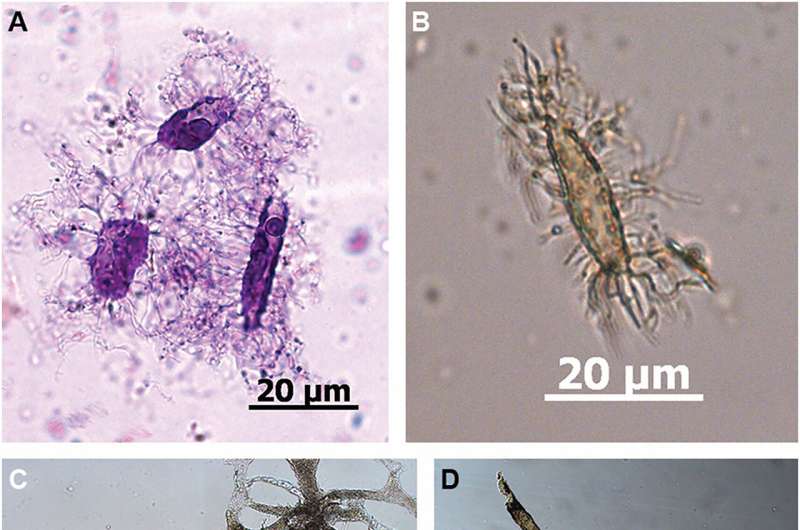This article has been reviewed according to Science X's editorial process and policies. Editors have highlighted the following attributes while ensuring the content's credibility:
fact-checked
trusted source
proofread
How are dinosaur tissues preserved in deep time?

Ever since Mary Schweitzer found soft, stretchy tissue in a T. rex fossil in 2004, scientists have been trying to come to grips with how some biological tissues and cells could preserve within ancient critters.
The most popular hypotheses involve a process called "crosslinking." Similar to the way formaldehyde is used to fix tissues and preserve them, crosslinking can also "fix" tissues of ancient organisms, including dinosaurs. (Remember that 7th grade frog dissection? Yeah, those frogs were preserved via crosslinking with formaldehyde.)
"Fixatives like formaldehyde keep the tissues from degrading—in part, they make them less digestible to bacteria," says Landon Anderson, doctoral candidate at NC State and lead author of a study in Earth Science Reviews. "But there are a number of different chemical pathways that can result in crosslinking. This work shows that at least two of the more popular hypotheses actually share a chemical pathway and overlap quite a bit. In many cases, they are one and the same."
A hypothesis from Schweitzer and her colleagues on crosslinking involves oxidation driven by certain dissolved metals, such as iron.
Simply put, iron, potentially from hemoglobin (blood), reacts with oxygen to damage biomolecules such as fats, proteins, carbohydrates, and DNA. It does this by creating free oxygen "radicals"—highly reactive oxygen molecules that can damage biomolecules. The damaged biomolecules form crosslinks (or bonds) with one another, which stabilizes their damaged structure. The end result is biomolecules altered by crosslinking, which stabilize the overall tissue.
Another leading crosslinking hypothesis from paleontologist Jasmina Wiemann and her colleagues relies on carbonyl groups of fats and carbohydrates as the starting point for crosslinking. Carbonyl groups are just carbon atoms that are, in a sense, strongly bonded to an oxygen atom. But they are prone to reacting with some biomolecules, like proteins and DNA. The end result is the same as with free oxygen radicals: crosslinked biomolecules and stabilization of ancient tissues.
"These hypotheses are not mutually exclusive," Anderson says. "In fact, the process Schweitzer described, free oxygen radicals damaging biomolecules, can produce either crosslinks or new carbonyl groups. So in some respects it can be a precursor to Wiemann's hypothesis."
Carbonyl groups can form in several ways, not just via free oxygen radicals, so that's where Schweitzer's and Wiemann's hypotheses diverge. But both roads lead to crosslinking.
"Because we didn't realize that these processes could come from the same starting place and share a step, the hypotheses have been presented as separate," Anderson says. "But I wanted to show the chemistry behind these ideas, and that it plausibly explains the soft tissues and cells we're seeing in, for example, dinosaurs. In fact, the chemistry from this paper potentially describes preservation for a variety of original cellular tissues, including vertebrates and other organisms trapped within amber, 'carbonized' traces of ancient feathers and skin, and even dinosaur 'mummies.'"
These two hypotheses, taken together, don't answer every question regarding soft tissue preservation in deep time. There is a lot left to explore.
The study by Anderson also delves into the processes of carbonization and sulfurization, in addition to the best conditions for preservation. Questions remain regarding how the predominant preservation pathways change under different environmental conditions, but Anderson believes that demystifying the general chemical theory behind the processes involved is an important first step.
"We know the reason for preservation is, largely, crosslinking of various sorts," Anderson says. "Now we have some chemical context for preservation hypotheses. We need to get over the idea that this kind of preservation could never happen. It's certainly reasonable, and we have a sound theoretical basis for why."
More information: Landon A. Anderson, A chemical framework for the preservation of fossil vertebrate cells and soft tissues, Earth-Science Reviews (2023). DOI: 10.1016/j.earscirev.2023.104367
Provided by North Carolina State University





















